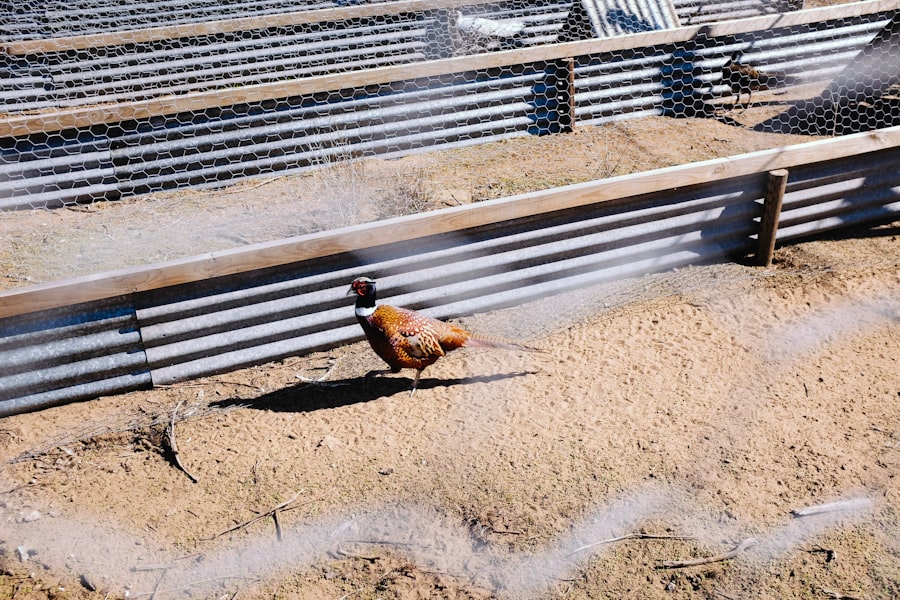Chickens are social animals with a hierarchical structure within their flock, known as a pecking order. Understanding their behavior is essential for effectively deterring them from specific areas. These birds are naturally inquisitive and explore their environment by pecking at objects that attract their attention.
They are particularly drawn to shiny surfaces, such as windows or car mirrors. Chickens also have a strong instinct to scratch and forage for food, which can lead them to disturb gardens and flower beds. Chickens are easily startled by sudden movements or loud noises, causing them to quickly flee from an area.
This flight response can be utilized when implementing deterrent techniques. By comprehending the natural behaviors of chickens, we can develop targeted methods to discourage them from unwanted areas without causing harm or distress to the birds. Territorial behavior is another important aspect of chicken psychology.
They will defend their space from perceived threats, which can result in aggression towards other animals or humans if they feel their territory is being invaded. Recognizing this territorial nature is crucial when implementing deterrent techniques, as it allows for the anticipation of potential conflicts and the implementation of proactive measures to prevent them. A thorough understanding of chicken behavior enables the development of effective strategies to deter them from specific areas while ensuring their welfare and safety.
Table of Contents
- 1 Creating Physical Barriers
- 2 Using Natural Deterrents
- 3 Implementing Visual Deterrents
- 4 Establishing Distraction Techniques
- 5 Training and Repellents
- 6 Seeking Professional Help
- 7 FAQs
- 7.1 What are some effective methods for keeping chickens out of a flower bed?
- 7.2 Are there any plants that can help repel chickens from a flower bed?
- 7.3 Is it safe to use chicken wire or other physical barriers to keep chickens out of a flower bed?
- 7.4 What are some natural deterrents that can be used to keep chickens out of a flower bed?
- 7.5 How can I train my chickens to stay out of the flower bed?
Key Takeaways
- Chickens are naturally curious and will explore their surroundings, so understanding their behavior is crucial in deterring them from unwanted areas.
- Physical barriers such as fences and netting can effectively keep chickens out of specific areas and protect gardens or crops.
- Natural deterrents like citrus peels, garlic, and hot pepper can be used to repel chickens from certain areas without causing harm to them.
- Visual deterrents such as scarecrows, reflective objects, and predator decoys can be effective in deterring chickens from specific areas.
- Distraction techniques like providing alternative feeding areas or toys can redirect chickens’ attention away from unwanted areas.
- Training chickens to avoid specific areas and using repellents like motion-activated sprays can be effective in deterring them from unwanted spaces.
- If all else fails, seeking professional help from a veterinarian or animal behaviorist can provide additional strategies for deterring chickens from unwanted areas.
Creating Physical Barriers
Fences and Netting
Fences should be tall enough to prevent the chickens from flying over them, and the bottom should be buried or secured to prevent the birds from digging underneath. Netting can be used to cover gardens or other areas that need protection from chickens, preventing them from accessing the plants or soil.
Chicken Wire and Hardware Cloth
Another physical barrier that can be effective in deterring chickens is the use of chicken wire or hardware cloth. These materials can be used to create enclosures or covers for specific areas, such as vegetable gardens or flower beds.
Motion-Activated Sprinklers
In addition to fences and netting, the use of motion-activated sprinklers can also serve as a physical barrier to deter chickens. These devices are triggered by the movement of the birds and release a burst of water, startling and discouraging them from entering the protected area.
By creating physical barriers, we can effectively deter chickens from specific areas while also ensuring their safety and well-being.
Using Natural Deterrents
In addition to physical barriers, natural deterrents can also be effective in deterring chickens from specific areas. One natural deterrent that can be used is the presence of predators or predator decoys. The sight or sound of potential predators, such as hawks or owls, can discourage chickens from entering an area.
Predator decoys, such as plastic owls or snakes, can also be effective in deterring chickens by creating the illusion of a potential threat. Another natural deterrent that can be used is the scent of certain plants or herbs that are unappealing to chickens. Plants such as lavender, mint, or marigolds have strong scents that can repel chickens and discourage them from entering specific areas.
These plants can be strategically placed around gardens or other areas that need protection from chickens to create a natural deterrent. Furthermore, the use of natural repellent sprays made from ingredients such as garlic, vinegar, or hot peppers can also be effective in deterring chickens. These sprays can be applied to plants or surfaces that need protection from chickens, creating a scent or taste that is unappealing to the birds.
By using natural deterrents, we can effectively discourage chickens from specific areas while also avoiding the use of harmful chemicals or substances.
Implementing Visual Deterrents
Visual deterrents can also be effective in deterring chickens from specific areas. One visual deterrent that can be used is the use of reflective surfaces or objects that create flashes of light. Chickens are naturally attracted to shiny objects, so the sight of reflective surfaces such as aluminum foil strips or CDs hanging in the area can discourage them from entering.
The flashes of light created by these objects can startle and deter the birds from approaching the protected area. Another visual deterrent that can be effective is the use of scarecrows or scare devices that create movement in the area. Scarecrows with moving parts or devices that create sudden movements can startle and discourage chickens from entering specific areas.
These visual deterrents take advantage of the birds’ natural instinct to flee from sudden movements and can effectively deter them from unwanted areas. In addition to reflective surfaces and scare devices, the use of visual barriers such as screens or mesh can also be effective in deterring chickens. These barriers create a visual obstruction that prevents the birds from seeing or accessing specific areas, effectively discouraging them from entering.
By implementing visual deterrents, we can effectively deter chickens from specific areas while also taking advantage of their natural instincts to avoid potential threats.
Establishing Distraction Techniques
Distraction techniques can be effective in redirecting the attention of chickens away from specific areas that need protection. One distraction technique that can be used is the provision of alternative feeding areas for the birds. By providing designated feeding areas with food and treats that are appealing to chickens, we can redirect their attention away from gardens or other areas that need protection.
Another distraction technique that can be effective is the use of toys or enrichment activities for the birds. Toys such as hanging treats or puzzle feeders can provide mental stimulation for the chickens and keep them occupied, reducing their interest in exploring unwanted areas. By establishing distraction techniques, we can effectively redirect the attention of chickens away from specific areas while also providing them with enrichment and stimulation.
In addition to providing alternative feeding areas and toys, the use of sound distractions such as wind chimes or music can also be effective in deterring chickens. The sound of wind chimes or music can create a pleasant distraction for the birds and discourage them from entering specific areas. By establishing distraction techniques, we can effectively redirect the attention of chickens away from unwanted areas while also providing them with enrichment and stimulation.
Training and Repellents

Positive Reinforcement Training
One effective technique for deterring chickens from specific areas is positive reinforcement training. By using treats and rewards, we can train the birds to associate specific cues with avoiding certain areas, effectively deterring them from entering those spaces.
Aversive Conditioning
Another effective technique is the use of aversive conditioning to discourage chickens from entering specific areas. Aversive conditioning involves creating negative associations with certain spaces by using deterrents such as loud noises or sudden movements when the birds approach those areas. This technique can effectively deter chickens from unwanted spaces by creating a negative experience associated with those areas.
Commercial Repellents
In addition to training techniques, the use of commercial repellents such as sprays or powders can also be effective in deterring chickens. These repellents are formulated with ingredients that create scents or tastes that are unappealing to the birds, effectively discouraging them from entering specific areas.
By using training techniques and repellents, we can effectively deter chickens from unwanted spaces while also ensuring their well-being and safety.
Seeking Professional Help
In some cases, seeking professional help may be necessary to effectively deter chickens from specific areas. Professional animal behaviorists or pest control experts have the knowledge and experience to develop tailored deterrent strategies based on the specific needs of each situation. These experts can assess the behavior of the chickens and identify the most effective deterrent methods to address the problem.
Furthermore, professional help may be necessary in cases where legal regulations or ethical considerations need to be taken into account when deterring chickens. Professional experts have the expertise to ensure that deterrent methods comply with legal requirements and ethical standards while effectively addressing the issue at hand. In addition to professional animal behaviorists and pest control experts, seeking help from local agricultural extension services or poultry organizations may also provide valuable insights and resources for effectively deterring chickens.
These organizations have access to resources and information on best practices for managing chicken-related issues and can provide guidance on implementing effective deterrent strategies. In conclusion, understanding the behavior of chickens is crucial in developing effective deterrent strategies to prevent them from accessing specific areas. By creating physical barriers, using natural and visual deterrents, establishing distraction techniques, implementing training and repellents, and seeking professional help when necessary, we can effectively deter chickens while ensuring their well-being and safety.
With careful consideration of their behavior and needs, we can develop humane and effective deterrent methods that protect our spaces while respecting the natural instincts of these curious and social animals.
If you’re looking for more tips on keeping chickens, you might be interested in this article on chicken coop run plans. It’s important to provide your chickens with a safe and secure environment, and having a well-designed coop and run can help keep them out of your flower beds.
FAQs
What are some effective methods for keeping chickens out of a flower bed?
Some effective methods for keeping chickens out of a flower bed include using physical barriers such as fences or chicken wire, using natural deterrents such as citrus peels or coffee grounds, and training the chickens to stay away from the flower bed.
Are there any plants that can help repel chickens from a flower bed?
Yes, there are some plants that can help repel chickens from a flower bed. These include plants with strong scents such as lavender, marigolds, and rosemary.
Is it safe to use chicken wire or other physical barriers to keep chickens out of a flower bed?
Yes, it is safe to use chicken wire or other physical barriers to keep chickens out of a flower bed. Just be sure to secure the barriers properly to prevent any potential harm to the chickens.
What are some natural deterrents that can be used to keep chickens out of a flower bed?
Some natural deterrents that can be used to keep chickens out of a flower bed include citrus peels, coffee grounds, and cayenne pepper. These items can be scattered around the flower bed to discourage the chickens from entering.
How can I train my chickens to stay out of the flower bed?
You can train your chickens to stay out of the flower bed by using positive reinforcement, such as offering treats when they stay away from the area, and by consistently redirecting them away from the flower bed when they approach it. Consistency is key in training chickens.
Meet Walter, the feathered-friend fanatic of Florida! Nestled in the sunshine state, Walter struts through life with his feathered companions, clucking his way to happiness. With a coop that’s fancier than a five-star hotel, he’s the Don Juan of the chicken world. When he’s not teaching his hens to do the cha-cha, you’ll find him in a heated debate with his prized rooster, Sir Clucks-a-Lot. Walter’s poultry passion is no yolk; he’s the sunny-side-up guy you never knew you needed in your flock of friends!







